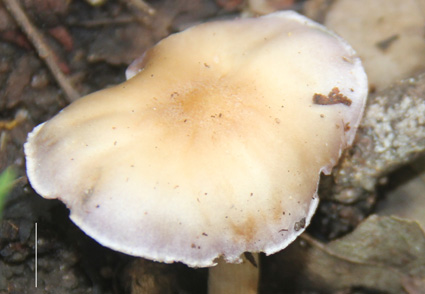Abstract
Tricholosporum tamilnaduense sp. nov. is reported here from the Eastern Ghats of Tamil Nadu, India. Tricholosporum tamilnaduense is well supported by the morphological characteristics by having broadly umbonate pale orange pileus 3.5–5 cm broad with a shallow central depression, violet-white margin, pale lilac emarginate lamellae and a short stipe 2.3–3.7 cm long, with an apex pruina; cruciate, hyaline, inamyloid basidiospores measuring 4–6 × 3–4 µm, clavate basidia 17–23 µm long and the cystidia bulbous or ampullaceous, measuring 16–35 µm long with a fusoid or mucronate apex. Further, the phylogenetic studies validate the morphological evidence for T. tamilnaduense sp. nov. through the nrDNA ITS sequence by forming a separate branch among the other Tricholosporum species. A description, illustrations, and phylogenetic analysis results of the new species are provided.
References
- Angelini, C., Contu, M. & Vizzini, A. (2014) Tricholosporum caraibicum (Basidiomycota, Tricholomataceae), a new species from the Dominican Republic. Mycosphere 5 (3): 430–439. https://doi.org/10.5943/mycosphere/5/3/6
- Angelini, P., Arcangeli, A., Bistocchi, G., Venanzoni, R. & Rubini, A. (2017) Tricholosporum goniospermum, genetic diversity and phylogenetic relationship with the Tricholomatineae [formerly tricholomatoid clade]. Sydowia 69: 9–18. https://doi.org/10.12905/0380.sydowia69-2017-0009
- Baroni, T.J. (1982) Tricholosporum and notes on Omphaliaster and Clitocybe. Mycologia 74: 865–871. https://doi.org/10.1080/00275514.1982.12021604
- Bohus, G., Vasas, G. & Locsmandi, C.S. (1999) Two new fungus species from Hungary (Basidiomycetes, Agaricales). In Annales historiconaturales Musei nationalis hungarici 91: 37–44
- Contu, M. & Mua, A. (2000) II genere Tricholosporum Guzmán (Basidiomycotina, Agaricomycetes) in Europa. Rivista di Micologia 43 (3): 249–258.
- Edler, D., Klein, J., Antonelli, A. & Silvestro, D. (2021) raxmlGUI 2.0: a graphical interface and toolkit for phylogenetic analyses using RAxML. Methods in ecology and evolution 12 (2): 373–377. https://doi.org/10.1111/2041-210X.13512
- Fernandez Vicente, J., Iglesias, P., Hidalgo, F. & Oyarzabal, M. (2010) Aportaciones al conocimiento micologico de la Isla de La Palma II y una nueva especie de Tricholosporum. Errotari 7: 84–131.
- Guzmán, G. (1975) Un nuevo genero y dos nuevas especies de Agaricaceos Mexicanos. Scientia Fungorum 9: 61–66.
- Guzmán, G., Montoya, L. & Bandala, V.M. (1990) Observations on the genera Asproinocybe and Tricholosporum and description of new species of Tricholosporum (Agaricales, Tricholomataceae). Mycotaxon 38: 485–495.
- Halling, R.E. & Franco, M.A.E. (1996) Agaricales from Costa Rica: New taxa with ornamented spores Mycologia 88 (4): 666–670. https://doi.org/10.1080/00275514.1996.12026702
- Heaton, K. & Kropp., B. (2013) Phylogenetic placement of the genus Tricholosporum by DNA sequencing. Biology Posters paper 126. https://digitalcommons.usu.edu/biology_posters/126
- Hu, Y., Karunarathna, S.C., Li, H., Galappaththi, M.C., Zhao, C.L., Kakumyan, P. & Mortimer, P.E. (2022) The impact of drying temperature on basidiospore size. Diversity 14 (4): 239. https://doi.org/10.3390/d14040239
- Tamura, K., Stecher, G. & Kumar, S. (2021) MEGA11: molecular evolutionary genetics analysis version 11. Molecular biology and evolution 38 (7): 3022–3027. https://doi.org/10.1093/molbev/msab120
- Kumar, M. (2020) A field guide to Mushrooms and other fungi of Tropical Dry Evergreen Forest of Peninsular India. Digital Age Publishers. [ISBN: 978-93-84692-09-4]
- Kumar, M. & Kaviyarasan, V. (2011) A rare agaric from a sacred grove of Eastern Ghats, India. Journal of Threatened Taxa 3 (5): 1778–1781. https://doi.org/10.11609/JoTT.o2626.1778-81
- Kumar, M. & Kaviyarasan, V. (2012) Carnivorous Mushroom from Eastern Ghats. Journal of Academic Industrial Research 1 (3): 137–139.
- Kumar, M., Nithya, S. & Agnes Kayalvizhi, A. (2021) First report of Trichaleurina javanica (Rhem) M. Carbone, Agnello & P. Alvarado (Ascomycota: Pezizales: Chorioactidaceae) from South India. Journal of Threatened Taxa 13 (5): 183–98. https://doi.org/10.11609/jott.6552.13.5.18398-18402
- Lebel, T., Syme, K., Barrett, M.D. & Cooper, J.A. (2020) Two new species of Asproinocybe (Tricholomataceae) from Australasia. Muelleria 38: 77–85. https://doi.org/10.5962/p.337581
- Liu, Y.C., Liu, P., Hu, H.P., Li, D. & Li, Y. (2016) Tricholosporum, a newly recorded genus of Agaricomycetes in China. Phytotaxa 289 (3): 263–270. https://doi.org/10.11646/phytotaxa.289.3.6
- Moreau, P.A. & Contu, M. (2007) Une espèce remarquable de l’étage thermoméditerranéen de Corse et de Sardaigne: Tricholosporum cossonianum (Maire) comb. nov. Bulletin semestriel de la Fédération des associations mycologiques méditerranéennes 32: 41–52.
- Mou, G.F. & Bau, T. (2021) Asproinocybaceae fam. nov. (Agaricales, Agaricomycetes) for Accommodating the Genera Asproinocybe and Tricholosporum, and Description of Asproinocybe sinensis and Tricholosporum guangxiense sp. nov. Journal of Fungi 7 (12): 1086. https://doi.org/10.3390/jof7121086
- Rathnayaka, A.R., Tennakoon, D.S., Jones, G.E., Wanasinghe, D.N., Bhat, D.J., Priyashantha, A.H., Stephenson, S.L., Tibpromma, S. & Karunarathna, S.C. (2024) Significance of precise documentation of hosts and geospatial data of fungal collections, with an emphasis on plant-associated fungi. New Zealand Journal of Botany 31: 1–28. https://doi.org/10.1080/0028825X.2024.2381734
- Reid, D.A., Eicker, A., Clémençon, H. & Roux, C. (1998) South African fungi 7: Tricholosporum laeteviolaceum sp. nov., a representative of a genus new to southern Africa. Mycotaxon 69: 409–418.
- Ronquist, F., Teslenko, M., Mark, P.V.D., Ayres, D.L., Darling, A., Hohna, S., Larget, B., Liu, L., Suchard, M.A. & Huelsenbeck, J.P. (2012) MrBayes 3.2: efcient Bayesian phylogenetc inference and model choice across a large model space. Systematic Biology 61 (3): 539–542. https://doi.org/10.1093/sysbio/sys029
- Rambaut, A. (2012) FigTree v1.4 README.
- Santhosh, D.B., Anilkumar, C., Akash, D., Prabhu, K.N., Earanna, N. & Gangaraju, P. (2017) A New Mushroom species Tricholosporum purpureolilacinus Recorded from Western Ghats of Karnataka. International Journal of Pure and Applied Bioscience 5 (3): 816–820. http://doi.org/10.18782/2320-7051.2803
- Singer, R. (1945) New and Interesting Species of Basidiomycetes. Mycologia 37 (4): 425–439. https://doi.org/10.2307/3754629
- Xu, J.Z., Zhang, C.L., Kasuya, T., Moodley, O., Liu, B.A.O., Gong, L.E.I. & Li, Y.U. (2018) A new species of Tricholosporum (Agaricales, Tricholomataceae) from Liaoning Province of China. Phytotaxa 374 (1): 63–70. https://doi.org/10.11646/phytotaxa.374.1.5


